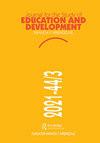The disciplinary borderlands of education: art and STEAM education (Los límites disciplinares de la educación: arte y educación STEAM)
IF 1.8
4区 教育学
Q4 PSYCHOLOGY, DEVELOPMENTAL
Journal for the Study of Education and Development
Pub Date : 2021-06-16
DOI:10.1080/02103702.2021.1926163
引用次数: 7
Abstract
ABSTRACT The emphasis on STEM disciplines in schools has caused advocates for art education to propose the addition of the arts to the study of science, technology, engineering and mathematics, transforming STEM into STEAM. However, it is important that the larger purposes of art and education that have traditionally been embraced by the liberal arts are not lost in STEAM education and that the arts are not reduced to a role of cognitive enhancer for other STEM subjects. STEAM education is closely linked to ideas and research about arts integration and is often implemented using the methods of ‘design thinking’. The use of design thinking as a method for interdisciplinary collaboration has many connections to how STEAM education is practise d in schools. Research describing arts integration is also relevant to how art is included in STEAM education. This article describes rationales for STEAM education and how the work of contemporary artists provides generative examples of how STEAM education might be put into practice. Both the affordances and limitations of STEAM education are explored.教育的学科边界:艺术与STEAM教育(Los límites disciplinares de la educación: arte y educación STEAM)
学校对STEM学科的重视使得艺术教育的倡导者提出在科学、技术、工程和数学的学习中加入艺术,将STEM转变为STEAM。然而,重要的是,传统上被文科所接受的艺术和教育的更大目的不能在STEAM教育中丢失,艺术不能沦为其他STEM科目的认知增强器。STEAM教育与艺术整合的思想和研究密切相关,通常采用“设计思维”的方法来实施。将设计思维作为跨学科合作的一种方法,与STEAM教育在学校的实践有很多联系。描述艺术整合的研究也与如何将艺术纳入STEAM教育有关。本文描述了STEAM教育的基本原理,以及当代艺术家的作品如何为STEAM教育的实践提供了创造性的例子。探讨了STEAM教育的优点和局限性。
本文章由计算机程序翻译,如有差异,请以英文原文为准。
求助全文
约1分钟内获得全文
求助全文

 求助内容:
求助内容: 应助结果提醒方式:
应助结果提醒方式:


